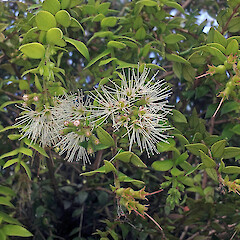Metrosideros colensoi
Common name
rātā
Synonyms
Metrosideros pendens Colenso, Metrosideros colensoi Hook.f. var. colensoi, Metrosideros colensoi var. pendens (Colenso) Kirk
Family
Myrtaceae
Flora category
Vascular – Native
Endemic taxon
Yes
Endemic genus
No
Endemic family
No
Structural class
Lianes & Related Trailing Plants - Dicotyledons
NVS code
The National Vegetation Survey (NVS) Databank is a physical archive and electronic databank containing records of over 94,000 vegetation survey plots - including data from over 19,000 permanent plots. NVS maintains a standard set of species code abbreviations that correspond to standard scientific plant names from the Ngä Tipu o Aotearoa - New Zealand Plants database.
METCOL
Chromosome number
2n = 22
Current conservation status
The conservation status of all known New Zealand vascular plant taxa at the rank of species and below were reassessed in 2017 using the New Zealand Threat Classification System (NZTCS) – more information about this can be found on the NZTCS website. This report includes a statistical summary and brief notes on changes since 2012 and replaces all previous NZTCS lists for vascular plants.
Please note, threat classifications are often suggested by authors when publications fall between NZTCS assessment periods – an interim threat classification status has not been assessed by the NZTCS panel.
- Conservation status of New Zealand indigenous vascular plants, 2017 . 2018. Peter J. de Lange, Jeremy R. Rolfe, John W. Barkla, Shannel P. Courtney, Paul D. Champion, Leon R. Perrie, Sarah M. Beadel, Kerry A. Ford, Ilse Breitwieser, Ines Schönberger, Rowan Hindmarsh-Walls, Peter B. Heenan and Kate Ladley. Department of Conservation. Source: NZTCS and licensed by DOC for reuse under the Creative Commons Attribution 4.0 International licence.
2017 | Threatened – Nationally Vulnerable | Qualifiers: DP, De
Previous conservation statuses
2012 | Not Threatened
2009 | Not Threatened
2004 | Not Threatened
Brief description
Woody long-climbing vine. Adult branches pendent. Adult leaves green, finely hairy, close-set and overlapping, sharp-tipped, surfaces without any obvious glandular spotting. Flowers terminal, fluffy, white or pink.
Distribution
Endemic. New Zealand: North Island (from central Northland south), South Island (Nelson and Marlborough to Westland and southern Marlborough / North Canterbury (Napenape)).
Habitat
Lowland to montane forest (particularly a vine seen in riparian and alluvial forest). Especially common in limestone areas on rock outcrops, in gorges, cliff faces and around cave entrances.
Detailed description
Slender to very slender vine up to 10 m tall. Bark grey to pale grey, ± tessellated, and flaking in tabular shards. Initial stems sparingly branched but soon much-branched, widely spreading, apices trailing and pendent. Branchlets subterete, pilose-pubescent (indument in mixtures or fine, short and long pilose brownish hairs). Leaves not markedly dimorphic, close-set to overlapping (± imbricate), submembranous to subcoriaceous, petiolate, ± subsessile; petioles 1–3 mm long, subterete; juvenile lamina 4–10 × 2–8 mm, ovate-lanceolate, base cuneate to almost truncate, apex acute to acuminate, initially yellow-green, adaxially maturing to green, abaxially paler, both surfaces finely covered in minute oil glands, and initially densely pubescent, ± glabrescent; adult lamina 8–20 × 5–20 mm, otherwise similar. Inflorescences terminal and lateral, white (rarely pink), comprising small, few-flowered cymes; peduncles and pedicels pubescent, peduncles 10–30 mm long, pedicels up to 3 mm long; hypanthia 5 mm long, narrowly- urceolate or -subglobose to ± funnelform, pubescent, hypanthium rim exceeding disc, calyx lobes 1.5-2.0 mm long, narrow deltoid, acute to acuminate, initially forward projecting, spreading with age. Petals 1.5–2.2 × 1.5–2.2 mm, orbicular, not or only scarcely exceeding calyx lobes. Stamens numerous, filaments 8–12 mm long, anthers yellow. Style 10–14 mm long, stigma capitate. Capsule 4-6 mm diameter, narrowly urceolate to subglobose, externally 3-ribbed, 3-valved. Seeds 0.6–1.1 mm long, narrowly elliptic, narrowly obovate or oblong, apex usually curved orange to orange-brown, unfilled seeds dark orange-brown.
Manaaki Whenua Online Interactive Key
Similar taxa
Readily distinguished from other similar small, white-flowered rata (Metrosideros diffusa and M. perforata) by the widely spreading, pendant branches, softly hairy, close-set, overlapping, ovate-lanceolate, acute to acuminate leaves (without obvious oil glands) and terminal, white to pink inflorescences.
Flowering
August–October
Flower colours
Red/Pink, White
Fruiting
December–April
Propagation technique
Although a beautiful species, M. colensoi is not commonly cultivated and it has a reputation for being difficult. Like all other climbing rātā it can be grown from rooted pieces and from semi-hardwood cuttings. However like all Metrosideros, cuttings can be fickle to strike. This species, once established is very hardy and tolerant of a range of conditions. The long drooping (pendent) branches and terminal clusters of white fluffy flowers are especially attractive when specimens are planted to grow up a wall or along a fence.
Threats
When myrtle rust (Austropuccinia psidii) was detected in New Zealand (May 2017) the conservation status was upgraded as a precautionary measure to ‘Threatened – Nationally Vulnerable’ because, on best advice, it was believed that no indigenous Myrtaceae had resistance to the myrtle rust disease (de Lange et al. 2018).
Myrtle rust (Austropuccinia psidii) is an invasive fungus that threatens native myrtle species. Learn more myrtlerust.org.nz.
Etymology
metrosideros: Iron heart
colensoi: Named after William Colenso (7 November 1811 - 10 February 1899) who was a Cornish Christian missionary to New Zealand, and also a printer, botanist, explorer and politician.
Attribution
Fact sheet prepared for NZPCN by P.J. de Lange (6 January 2013). Description from herbarium specimens and fresh material.
NZPCN Fact Sheet citation
Please cite as: de Lange, P.J. (Year at time of access): Metrosideros colensoi Fact Sheet (content continuously updated). New Zealand Plant Conservation Network. https://www.nzpcn.org.nz/flora/species/metrosideros-colensoi/ (Date website was queried)















